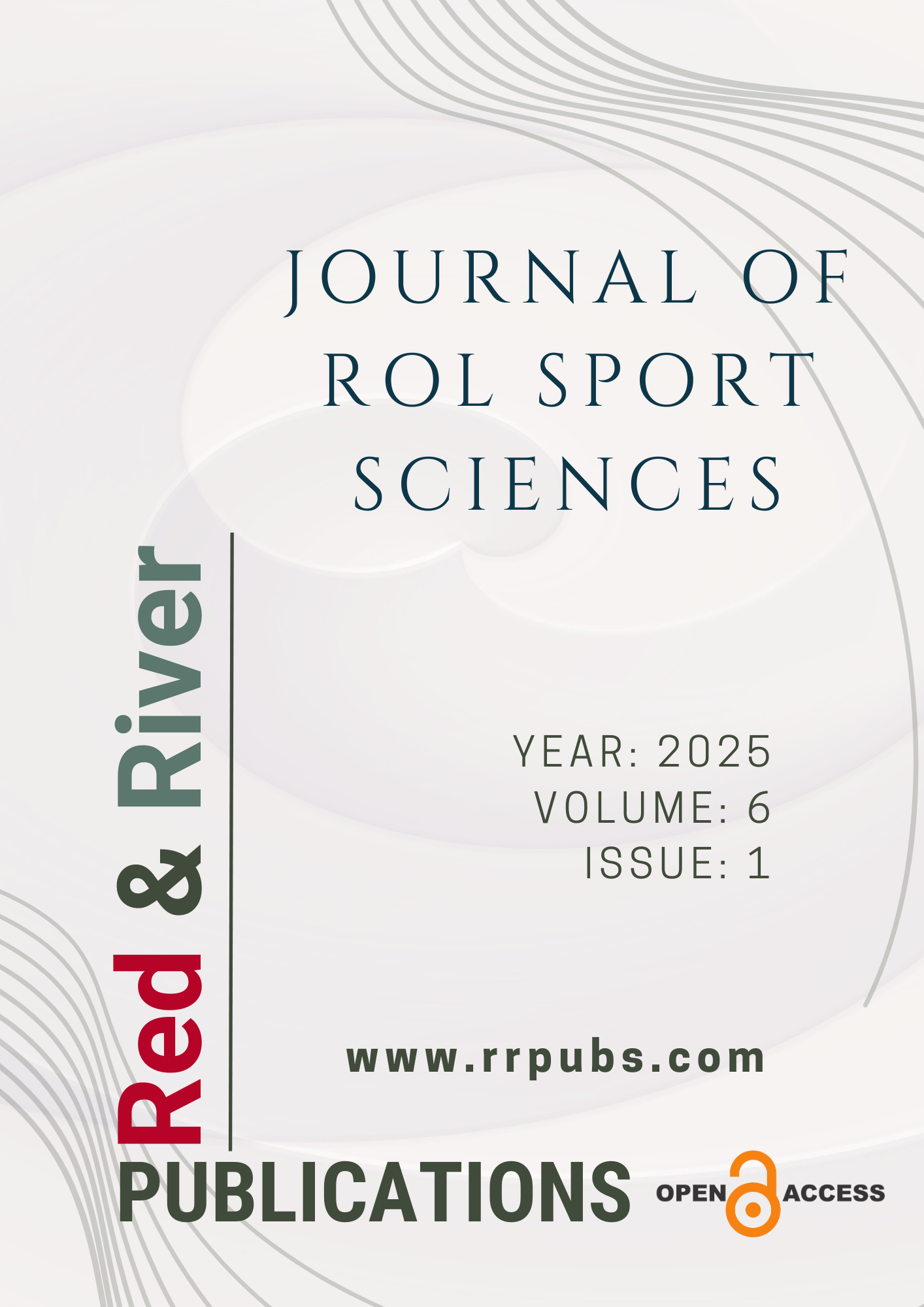Recreational swimming and infectious disease risks in young adults: An analysis of awareness and preventive measures
DOI:
https://doi.org/10.70736/jrolss.537Keywords:
Swimming, Infectious diseases, Adult healthAbstract
This study aimed to examine the risk awareness of infectious diseases and protective behaviors among young adults engaged in recreational swimming, considering various variables. A relational survey method was employed, and data were collected from 182 individuals (79 women, 103 men) using a demographic information form and the Infectious Diseases Risk Awareness and Protection Scale. Within the scope of data analysis, frequency and percentage distributions were examined, and after the normality assumptions were met, independent sample t-test, one-way ANOVA, Post-Hoc tests and Pearson Correlation analysis were applied. Participants’ mean age (years) was 28.46±4.23, height (cm) 172.82±8.70, body weight (kg) 71.46±13.24, and BMI 23.76±2.90. Significant differences were observed in total and subscale scores based on gender, while some subscales varied according to marital status, smoking habits, chronic diseases, and educational background (p<0.05). Different levels and directional relationships were found between demographic characteristics and scale scores. The findings indicated that awareness and protective behaviors differed by gender, marital status, education level, smoking habits, chronic diseases, and physical characteristics, with women and individuals with higher education levels scoring higher. Additionally, a negative correlation was identified between physical characteristics and awareness levels. In this context, it was concluded that educational programs should be organized to enhance awareness of infectious disease risks and that strategies should be implemented to improve protective behaviors.
References
Akdeniz, E. (2019). Sigara bağımlılığı sağlığa etkileri ve sigara bıraktırmada kullanılan transteoretik model. Kırşehir Ahi Evran Üniversitesi Sağlık Bilimleri Dergisi, 2(3), 11-25.
Alpar R. Applied statistics and validity-reliability: with examples from sports, health and educational sciences (3rd Edition). Ankara: Detay Publishing. 2014, 20-40.
Arden, M. A., & Chilcot, J. (2020). Health psychology and the coronavirus (COVID-19) global pandemic: A call for research. British Journal of Health Psychology, 25(2), 231–232. https://doi.org/10.1111/bjhp.12414 DOI: https://doi.org/10.1111/bjhp.12414
Arıca, E. Ö., Kuş, B., İnci, C., Söğüt, M. C. (2024). Pandemi sürecinde bireylerin bulaşıcı hastalıklara yönelik risk farkındalığı ve korunma düzeylerinin belirlenmesi: Türk toplumu örneği. Sağlık ve Toplum, 34(3), 74-82.
Avcikurt, C., Koroglu, O., Koroglu, A., & Avcikurt, A. S. (2011). HIV/AIDS awareness and attitudes of tour guides in Turkey. Culture, Health & Sexuality, 13(2), 233-243. DOI: https://doi.org/10.1080/13691058.2010.522733
Ayranci, U. (2005). AIDS knowledge and attitudes in a Turkish population: an epidemiological study. BMC Public Health, 5, 1-10. DOI: https://doi.org/10.1186/1471-2458-5-95
Barna, Z., & Kádár, M. (2012). The risk of contracting infectious diseases in public swimming pools: A review. Annali dell’Istituto superiore di sanita, 48, 374-386. DOI: https://doi.org/10.4415/ANN_12_04_05
Chan, E., & MacLeod, M. (2014). A comparison of recreational water illness awareness and frequency of swimming. BCIT Environmental Public Health Journal. https://doi.org/10.47339/ephj.2014.141 DOI: https://doi.org/10.47339/ephj.2014.141
Cohen J. The analysis of variance. In Statistical Power Analysis for the Behavioral Sciences (second ed.). Lawrence Erlbaum Associates. 1988, 274-87.
Colado, J. C., Triplett, N. T., Tella, V., Saucedo, P., & Abellán, J. (2009). Effects of aquatic resistance training on health and fitness in postmenopausal women. European Journal of Applied Physiology, 106(1), 113–122. https://doi.org/10.1007/s00421-009-0996-7 DOI: https://doi.org/10.1007/s00421-009-0996-7
Control and Prevention (CDC). (2021). Healthy swimming. https://www.cdc.gov/healthywater/swimming/index.html
Dalyan, O., Canpolat, E., Öztürk, Ö. F., & Pişkin, M. (2023). Gıda sektöründe çalışanların salgın hastalık farkındalıkları: Çanakkale ili örneği. Journal of Advanced Research in Natural and Applied Sciences, 9(4), 952-963. DOI: https://doi.org/10.28979/jarnas.1246775
Ener, D. & Çetinkaya, F. (2021). Bulaşıcı hastalıklar risk farkındalığı ve korunma ölçeği geliştirme. İstanbul Tıp Fakültesi Dergisi, 85(2). 258-269. DOI: https://doi.org/10.26650/IUITFD.973903
Fewtrell, L., & Kay, D. (2015). Recreational water and ınfection: A review of recent findings. Current Environmental Health Reports, 2(1), 85–94. https://doi.org/10.1007/s40572-014-0036-6 DOI: https://doi.org/10.1007/s40572-014-0036-6
Field, A. (2024). Discovering statistics using IBM SPSS statistics. Sage publications limited.
Godbey, G., Crawford, D. W., & Shen, X. S. (2010). Assessing hierarchical leisure constraints theory after two decades. Journal of Leisure Research, 42(1), 111-134. DOI: https://doi.org/10.1080/00222216.2010.11950197
Graczyk, T. K., Sunderland, D., Awantang, G. N., Mashinski, Y., Lucy, F. E., Graczyk, Z., ... & Breysse, P. N. (2010). Relationships among bather density, levels of human waterborne pathogens, and fecal coliform counts in marine recreational beach water. Parasitology Research, 106, 1103-1108. DOI: https://doi.org/10.1007/s00436-010-1769-2
Hlavsa, M. C., Roberts, V. A., Anderson, A. R., Hill, V. R., Kahler, A. M., Orr, M., ... et al. (2011). Surveillance for waterborne disease outbreaks and other health events associated with recreational water—United States, 2007–2008. MMWR Surveill Summ, 60(12), 1-32.
Kaya, G., Trabzon, Ş., Doğanay, S., Güçlü, E., Karabay, O., & Altındiş, S. (2019). Sağlık Eğitimi Alan Üniversite Öğrencilerine Verilen El Hijyeni Eğitimi Etkinliği. Journal of Biotechnology and Strategic Health Research, 3(3), 219-224. DOI: https://doi.org/10.34084/bshr.649305
Medical Park (MP). (2020). Kronik hastalıklar ve bağışıklık sistemi. Medical Park. https://www.medicalpark.com.tr/kronik-hastalik/hg-2369?utm_
Montazeri, A. (2005). AIDS knowledge and attitudes in Iran: results from a population-based survey in Tehran. Patient education and counseling, 57(2), 199-203. DOI: https://doi.org/10.1016/j.pec.2004.05.014
Özdamar K. Ölçek ve test geliştirme yapısal eşitlik modellemesi. Nisan kitabevi, Eskişehir 2017.
Pond, K. (2005). Water recreation and disease: Plausibility of associated infections. Geneva: World Health Organization.
Prüss-Üstün, A., Wolf, J., Corvalán, C., Bos, R., & Neira, M. (2016). Preventing disease through healthy environments: a global assessment of the burden of disease from environmental risks. World Health Organization.
Sanyaolu, A., Okorie, C., Marinkovic, A., Patidar, R., Younis, K., Desai, P., ... et al. (2020). Comorbidity and its impact on patients with COVID-19. SN Comprehensive Clinical Medicine, 2, 1069-1076. DOI: https://doi.org/10.1007/s42399-020-00363-4
Tabachnick, B.G., & Fidell, L.S. (2013). Using Multivariate Statistics (6th Ed.). Boston: Allyn & Bacon.
World Health Organization (2020). COVID-19 global risk communication and community engagement strategy – interim guidance. https://www.who.int/publications/i/item/covid-19-global-risk-communication-and-community-engagement-strategy
World Health Organization. (2021). Guidelines on recreational water quality. Volume 1: Coastal and fresh waters. World Health Organization.
World Health Organization. (2022). Health literacy development for the prevention and control of noncommunicable diseases. Volume 1: Overview. World Health Organization.
Downloads
Published
How to Cite
Issue
Section
License
Copyright (c) 2025 Journal of ROL Sport Sciences

This work is licensed under a Creative Commons Attribution 4.0 International License.

